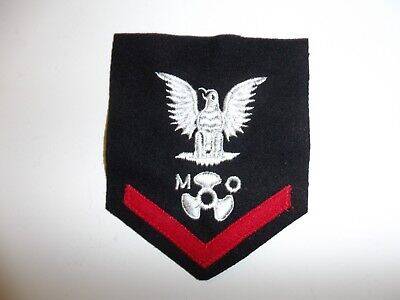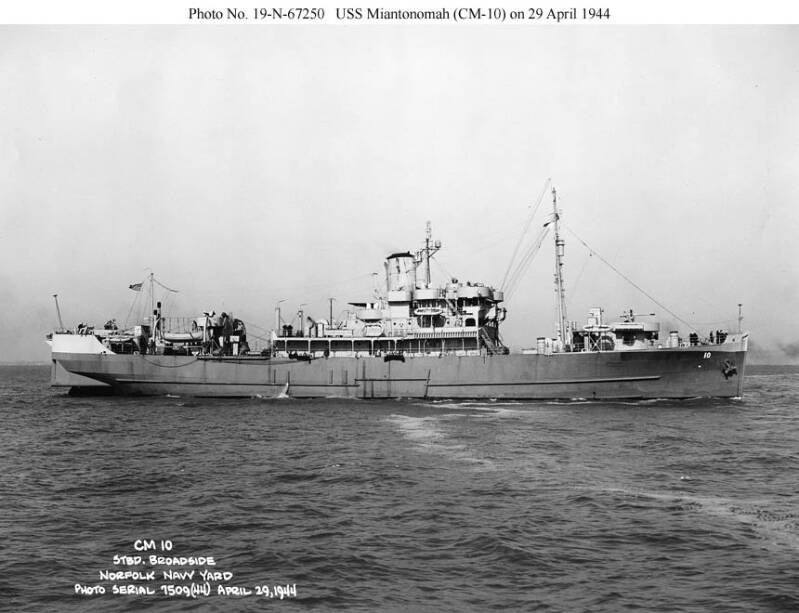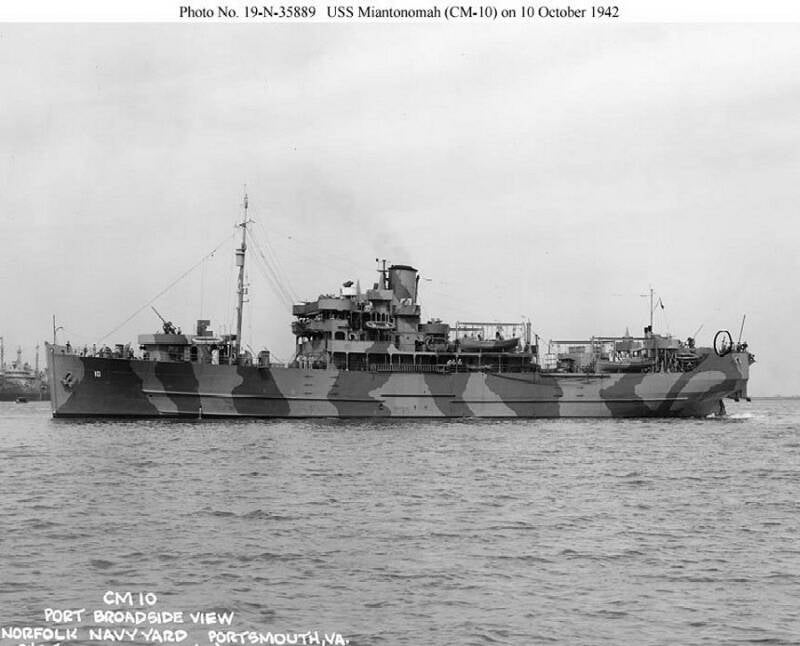Military Life

Motor Machinist's Mate 3rd Class Badge

Rank at Time of Death: Petty Officer 3rd Class
Enlistment Date: 5 February, 1943
General Equipment: Steam engines, turbines, auxiliary engines,
pumps, distillation plants,
and drainage systems
Location of Death: Le Havre, France
Motor Machinist Mate Responsibilities include:
- Operating ship boilers, steam turbines, turbo generators, and water desalination plants
- Maintaining auxiliary machinery including steering engines, elevators, winches, pumps and valves
- Repairing valves, pumps, heat exchangers, compressors, steam turbines and hydraulic/pneumatic devices
- Cleaning/adjusting/testing boilers, engines and generators
- Creating/analyzing machinery operating reports/records
- Aligning piping systems for oil, water, air and steam
USS Miantonomah Background
USS Miantonomah (CM-10) on 29 April 1944
Before Miller was enlisted, the USS Miantonomah joined the effort to reduce the German submarine menace along the East Coast on 11 January 1942. During the next several months, it owed mines off Cape Hatteras and Key West. Later, defensive mine operations sent her to the southern reaches of the Caribbean off Trinidad. In October after being reclassified as CM-10 rather than CMc-5, the Miantonomah completed preparations for oversea combat duty.
Guided by Raven (AM-55) on November 7, she rejoined the Western Naval Task Force after a short period of separation. They were approaching to launch a three-pronged invasion of French Morocco. The Miantonomah laid down a defensive minefield North and East of the transport area by the next day. On November 11th and 12th she had escaped damage from two German submarine attacks. Despite her escape, two US ships had been damaged and four had been sunk due to German torpedoes.
From November 12 and 15, the Miantonomah steamed in convoy to Casablanca, loaded mines from Terror (CM-5). On the 16th, she extended the Fedala minefield along the Moroccan coast to Casablanca with the Moadnock and Terrior. The next day, the ship left for the US and arrived in Yorktown on November 30th.
After a series of repairs at Norfolk from December to mid-January 1943, the Miantonomah operated in Boston from April to the end of May. Then, following her return to Yorktown, she departed June 14th and arrived in Trinidad on the 20th to sow mines. The ship returned o Chesapeake a month later and operated in Yorktown for 9 months. In April 1944, she departed from Gravesand Bay, NJ to support the Allied invasion of Europe.
Miantonomah arrived in Bristol, England on May 16th and began duty with the 12th fleer. She left for Plymouth on D-Day (June 6). She continued to dispatch and escort duties in British waters until arriving at Grandcamp France in June. There, she became a flagship for CTF-125 and then steamed to Cherbourg on July 9th. The ship left for Plymouth and then returned to Cherbourg on July 20th carrying supplies for port clearance operations. For more than two months, she made runs between English and liberated French ports to provide valuable support for salvage/clearing operations. On September 21st, Miantonomah carried port clearance supplies from Cherbourg to Le Havre, France which had been liberated less than two weeks prior.
On the 25th the ship was sailing in the early afternoon and Comdr. Austin E. Rowe order, "the highest state of watertight integrity to be set and all personnel not actually on watch below to be on topside and wear life jackets". These measures saved many lives that day. She skillfully navigated the inner and outer harbors of the channel but as she was about 2,000 yards out from the block ships, she was hit at 14:15 (2:15 pm) by a tremendous underwater explosion under the engine room. The blast--possibly followed by a second one--dazed or injured almost the entire crew. The Miantonomah immediately began to sink rapidly. Damage control efforts proved useless as Coast Guard Vessels, British Motor Launches and a French Fishing Craft stood by to rescue survivors, the injured commander order for the ship to be abandoned. The ship sank about 20 minutes after the explosion with casualties of at least 58 officers and men.
USS Miantonomah (CM 10) Info
USS Miantonomah on 10 October 1942 taken by Robert Hurst

Named SS Quaker by Pusey and Jones Corp, Wilmington, Delaware
Date Acquired by the Navy: 5 May 1941
Classified as Coastal Minelayer, CMc-5
Commissioned as USS Miantonomah (CMc-5) on 13 November, 1941
Reclassified as a Minelayer (CM-10) on 15 May 1942
Cause of Sinking: Struck a mine
Date of Sinking: 25 September 1944
Place of Sinking: Le Havre, France
The USS Miantonomah strongly resembles the appearance of its sister Monadnock (CMc-4)
Commanding Officers of the USS Miantonomah:
LCDR Raymond Dorsey Edwards USN
CDR Austin Edward Rowe, USN
Create Your Own Website With Webador